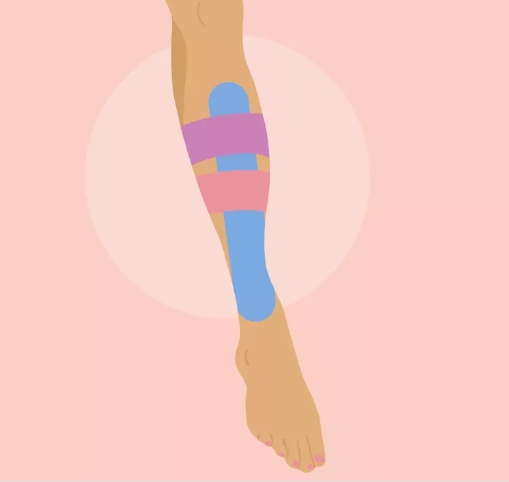When it comes to tapping strapping KT tapes, understanding the intricacies of this therapeutic method is crucial for athletes and individuals alike. In this blog post, we will delve deep into the world of kinesio tape, exploring its applications and benefits.
We’ll start by discussing what kinesiology taping is, shedding light on its origins and purposes in sports medicine. Next, we’ll outline the numerous benefits that come with using these techniques – from injury prevention to enhanced performance.
Moving forward, you can expect an in-depth analysis of how kinesiology taping works at a physiological level. Moreover, we’ll give you a thorough breakdown of how to apply kinesio taping for popular issues like shin splints, shoulder pain and tennis elbow. By the end of this comprehensive guide on tapping strapping kinesio tape, you will have gained valuable knowledge to help improve your athletic performance or alleviate discomfort from various ailments.
What is Taping and Strapping?
Taping and strapping are techniques used by athletes, sportspeople, and physical therapists to provide support, stability, and protection to muscles and joints during physical activity. These methods involve the application of kinesiology taping directly onto the skin or over a pre-wrap material. The primary goal of taping and strapping is to prevent injuries while allowing for optimal movement.
The Different Types of Tapes
-
Athletic Tape: This rigid tape provides strong support for joints like ankles, wrists, knees, etc., by limiting their range of motion. Athletic tape is often used in sports like football and basketball, where sudden movements can lead to injuries.
-
Kinesiology Tape (KT Tape): Kinesiology tape is a more flexible type of tape that allows for better freedom of movement without compromising on support. This tape allows the connective tissue surrounding the affected muscle or tendon to move along with the body. It’s popular among runners, swimmers, and cyclists who require full mobility during their activities.
The Purpose Behind Taping & Strapping Techniques
Taping strapping can help with the following:
-
Injury Prevention: By providing additional support with KT tape to vulnerable areas such as ligaments, tendons, and muscles, taping and strapping can help prevent soft tissue injury from occurring during physical activities.
-
Injury Management: For those recovering from an injury or surgery, KT tape can be used to restrict movement in the affected area while still allowing for some level of activity. This helps maintain muscle strength without aggravating the injury.
-
Pain Relief: Kinesiology taping may also support muscles, provide pain relief and relieve muscle pain by reducing pressure on injured tissues. The support offered by KT tape allows for better distribution of forces across a joint which reduces stress on individual structures like ligaments or tendons.
Taping and strapping is a form of physiotherapy treatment that assists in bolstering articulations, muscles, tendons and ligaments during physical activities. It can also help reduce pain from muscle strain.
Benefits of Taping and Strapping
Using kinesiology tape provides numerous benefits for athletes, from improved performance to reduced risk of injury. In this section, we will discuss the potential advantages that can be gained by incorporating taping and strapping into your physical therapy routine.
Improved Performance
The primary goal of any athlete is to perform at their best during training sessions or competitions. By enhancing proprioception through kinesiology tape, athletes can improve stability and their ability to sense body position in space, leading to more efficient movement with greater control. This enhanced awareness allows athletes to move more efficiently with better control over their movements.
Reduced Risk of Injury
Injuries are an unfortunate reality for many sportspeople. However, using kinesio tape can significantly reduce the likelihood of sore muscles as well as sustaining injuries such as sprains or strains by providing additional support for vulnerable areas like ankles or knees. Moreover, these techniques also help prevent re-injury by restricting excessive movement while still allowing a safe range of motion.
-
Ankle Sprain Prevention: One common application is the use of tape around the ankle joint after a previous sprain has occurred – this helps stabilize the area during activity without hindering mobility too much.
-
Knee Support: Athletes who suffer from patellar tendonitis may benefit from applying KT tape below their kneecap – it provides targeted compression on the tendon which reduces pain levels while simultaneously promoting healing processes within damaged tissues.
Faster Recovery Time
Athletes are always looking for ways to speed up their recovery time and get back in the game as soon as possible. The application of kinesiology tape can play a crucial role in this process by promoting blood flow, reducing inflammation, and providing support during rehabilitation exercises. For example, kinesio tape has been shown to improve lymphatic drainage which helps reduce swelling around injured areas.
Increased Confidence
Last but not least, kinesio tape can provide a psychological boost for athletes who may be hesitant about returning to their sport after an injury. Kinesio taping can supply athletes with a feeling of trustworthiness, providing them assurance that they are less likely to experience another injury or have further issues during their physical activity.
Incorporating kinesio taping into your sports routine is an effective way of maximizing performance while minimizing injury risk. With proper application techniques, you can reap the benefits of improved proprioception, faster recovery times, reduced pain levels – all leading towards increased confidence on the field or court.
Kinesio taping provides a range of benefits for athletes, from reducing pain to providing stability during physical activity.
How Kinesio Tape Works
Kinesiology Tape (KT) works by creating a lifting effect on the skin, which can help reduce pressure on pain receptors and improve circulation in the area. This section will provide step-by-step instructions on how to properly apply tapes and straps for maximum benefit.
To ensure proper application, measure the length needed for each muscle or joint you plan to support using your chosen tape’s guidelines. Cut your kinesiology tape accordingly while rounding off any sharp edges as they may peel away from the skin more easily. Clean skin before applying the kinesiology tape as lotions or oils can interfere with the adhesion of the tape.
Identify two anchoring points where both ends of the kinesiology tape is secured. Apply tension along the middle portions between the anchor points eg. 50% stretch for muscle support, 75-100% stretch for joint stability.
Press firmly on the anchor points and the middle portions of the tape to ensure it adheres to the skin without wrinkles.
Kinesiology tape is designed to stay on for about 3-4 days. To remove kinesiology tape comfortably, gently pull the tape away from the skin in the direction of hair growth. If you are having difficulty removing the tape, apply a small amount of oil or lotion to help loosen adhesion.
How to Apply Kinesiology Tape for Shin Splints

Photo: CAITLIN-MARIE MINER ONG
Shin splints, also known as medial tibial stress syndrome, are a common overuse injury that affects athletes and sports enthusiasts. They can cause pain along the shinbone and may even lead to more severe injuries if left untreated. Kinesio taping is an effective way to provide support and alleviate pain caused by shin splints.
Step 1: Measure the Tape Length
-
Cut 1 full strip long enough to cover the length of your lower leg from just below your knee down toward your ankle.
-
Cut another 2 half strips that go perpendicular to the full strip.
Step 2: Anchor Points Application
-
Full strip: Remove the backing paper, anchor one end at the base of the shin around ankle. Using one hand, apply strip up the shin, directly over the point of pain, providing a light stretch. Smooth your other hand over the strip. Press firmly onto the last 2 inches without stretching
-
Half strips: With no stretch, remove the backing paper and gently apply anchor on outside of leg, perpendicular to full strip and roughly 1 inch above the point of pain. Hold anchor with one hand, then apply moderate stretch across the shin. Smooth your other hand over the strip and press firmly down at the last 2 inches without stretching. Repeat the same with the second half strip 1 inch below the point of pain.
Step 3: Rub the Tape for Better Adhesion
Rubbing the applied kinesio taping strap helps activate its adhesive properties, ensuring that it stays in place during physical activity. Use your fingers or a small towel to gently rub over each strip for a few seconds.
Remember that proper applicationof the kinesio taping is crucial for maximizing the benefits of taping and strapping when dealing with shin splints.
How to Apply Kinesiology Tape for Shoulder Pain

Photo: CAITLIN-MARIE MINER ONG
If you’re experiencing shoulder pain, using kinesio elastic tape can provide support and relief.
Step 1: Measure and Cut Your Tape
-
Cut 2 full strips of kinesio therapeutic tape about 8 inches.
Step 2: Anchor Point Application
-
Remove the backing paper and place an anchor about 4 inches below the shoulder joint on the outside of arm, around your triceps. Rest your injured arm across your body so you can provide some stretch to the tape as you anchor the other end at the back of the shoulder, all the way to the top of the shouder.
-
Place another anchor on the inside of your arm, closer to biceps, directly next to the starting point of strap 1 after removing the backing paper. Straighten your injured arm and turn palm upwards. Gently apply the KT tape up the front of the shoulder with a light stretch. Hold anchor down at the end without stretch. Make sure the 2 strips don’t overlap.
Step 3: Test Your Range of Motion
Gently move your arm through its full range of motion to ensure that the tape is not restricting movement or causing discomfort. If needed, adjust the KT tape accordingly.
How to Apply Kinesiology Tape for Tennis Elbow

Photo: CAITLIN-MARIE MINER ONG
Tennis elbow, also known as lateral epicondylitis, is a common overuse injury that affects the tendons connecting the forearm muscles to the outer part of the elbow. Applying kinesiology tape can help alleviate pain and support healing by providing stability and reducing pressure on these tendons.
Step 1: Measure and Cut Your Tape
-
Cut 1 full strip of KT tape approximately 10 inches long.
-
Cut another half strip
Step 2: Anchor Point Application
-
Bring your affected arm across your chest, bend your elbow and rest fingers on opposite shoulder. Remove the backing paper and apply one anchor directly above the outside of your elbow around the body prominence also called the lateral epicondyle. Do not apply any stretch at the anchor. Provide a slight stretch in the middle as you apply the KT tape around your forearm, following the natural curve of the forearm muscles. Apply the last 2 inches without stretch.
-
Apply an anchor on the back of your forearm just below elbow, slowly directing strip towards the front of your forearm after removing the backing paper. Apply stretch in the middle of the strap as the second KT tape strap intersect the first. Apply the last 2 inches without stretch.
The KT tape should now be properly applied for tennis elbow support. It’s important to monitor how your skin reacts to the tape, especially if you have sensitive skin or allergies. If any skin discomfort or inflammation appears, take the tape off right away and contact your physiotherapist.
Frequently Asked Questions Tapping Strapping Kt Tapes
What is the difference between strapping tape and kinesiology tape?
Strapping tape, also known as athletic or sports tape, is rigid and non-elastic. It’s used to immobilize joints and provide support during physical activity. Kinesiology tape (KT), on the other hand, is elastic and flexible, allowing for a full range of motion while providing support to muscles and joints without restricting movement. This study highlights their differences.
What is the purpose of taping and strapping techniques?
Taping and strapping techniques are primarily used for injury prevention or rehabilitation purposes by providing stability to muscles or joints that have been injured or are at risk due to overuse or weakness. They can help reduce pain levels during physical activities while promoting healing through increased blood flow.
What is the difference between the colors of KT tape?
There are no physical or chemical differences between the colors of kinesio tape. The colorful tape were developed with the idea of colour therapy.
Use Tapping and Strapping to Help with Injury Prevention
Taping and strapping with KT tapes can be a great way to provide support for sports injuries, repetitive overuse injuries, shoulder pain, tennis elbow and shin splints. Gaining knowledge of the correct way to apply KT tape is essential for obtaining optimal results from taping and strapping. By understanding the benefits of taping and strapping with KT tapes as well as learning how to correctly apply them you will be able take control of your physical health so that you can stay active longer without fear of injury or re-injury.
Contact us to book your next appointment with one of our Doreen physio.
